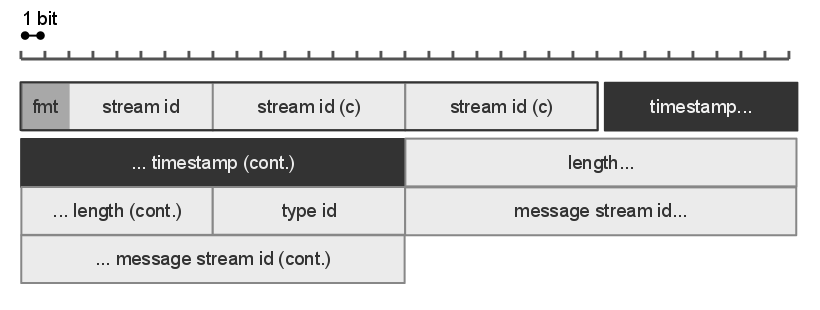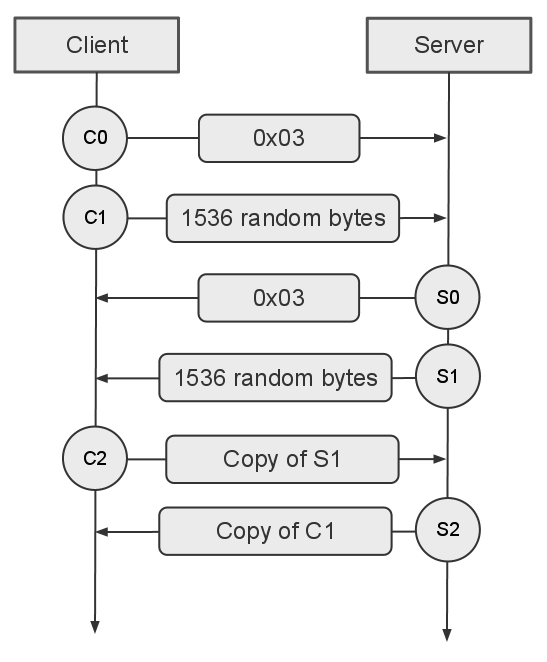|
Real-Time Messaging Protocol
Real-Time Messaging Protocol (RTMP) is a communication protocol for streaming audio, video, and data over the Internet. Originally developed as a proprietary protocol by Macromedia for streaming between Flash Player and the Flash Communication Server, Adobe (which acquired Macromedia) has released an incomplete version of the specification of the protocol for public use. The RTMP protocol has multiple variations: # RTMP proper, the "plain" protocol which works on top of Transmission Control Protocol (TCP) and uses port number 1935 by default. # RTMPS, which is RTMP over a Transport Layer Security (TLS/SSL) connection. # RTMPE, which is RTMP encrypted using Adobe's own security mechanism. While the details of the implementation are proprietary, the mechanism uses industry standard cryptographic primitives. # RTMPT, which is encapsulated within HTTP requests to traverse firewalls. RTMPT is frequently found utilizing cleartext requests on TCP ports 80 and 443 to bypass most corporat ... [...More Info...] [...Related Items...] OR: [Wikipedia] [Google] [Baidu] |
Communication Protocol
A communication protocol is a system of rules that allows two or more entities of a communications system to transmit information via any kind of variation of a physical quantity. The protocol defines the rules, syntax, semantics (computer science), semantics and synchronization of communication and possible Error detection and correction, error recovery methods. Protocols may be implemented by Computer hardware, hardware, software, or a combination of both. Communicating systems use well-defined formats for exchanging various messages. Each message has an exact meaning intended to elicit a response from a range of possible responses pre-determined for that particular situation. The specified behavior is typically independent of how it is to be Implementation, implemented. Communication protocols have to be agreed upon by the parties involved. To reach an agreement, a protocol may be developed into a technical standard. A programming language describes the same for computations, ... [...More Info...] [...Related Items...] OR: [Wikipedia] [Google] [Baidu] |
Overhead (engineering)
In engineering, some methods or components make special demands on the system. The extra design features necessary to meet these demands are called overhead. For instance, in electrical engineering, a particular integrated circuit might draw large current, requiring a robust power delivery circuit and a heat-dissipation mechanism. Example An example from software engineering is the encoding of information and data. The date and time ''"2011-07-12 07:18:47"'' can be expressed as Unix time with the 32-bit signed integer 1310447927, consuming only 4 bytes. Represented as ISO 8601 formatted UTF-8 encoded string 2011-07-12 07:18:47 the date would consume 19 bytes, a size overhead of 375% over the binary integer representation. As XML this date can be written as follows with an overhead of 218 characters, while adding the semantic context that it is a CHANGEDATE with index 1. 2011 07 12 07 18 47 The 349 bytes resulting from the UTF-8 encoded XM ... [...More Info...] [...Related Items...] OR: [Wikipedia] [Google] [Baidu] |
RTMPE
Real-Time Messaging Protocol (RTMP) is a communication protocol for streaming audio, video, and data over the Internet. Originally developed as a proprietary protocol by Macromedia for streaming between Flash Player and the Flash Communication Server, Adobe (which acquired Macromedia) has released an incomplete version of the specification of the protocol for public use. The RTMP protocol has multiple variations: # RTMP proper, the "plain" protocol which works on top of Transmission Control Protocol (TCP) and uses port number 1935 by default. # RTMPS, which is RTMP over a Transport Layer Security (TLS/SSL) connection. # RTMPE, which is RTMP encrypted using Adobe's own security mechanism. While the details of the implementation are proprietary, the mechanism uses industry standard cryptographic primitives. # RTMPT, which is encapsulated within HTTP requests to traverse firewalls. RTMPT is frequently found utilizing cleartext requests on TCP ports 80 and 443 to bypass most corpor ... [...More Info...] [...Related Items...] OR: [Wikipedia] [Google] [Baidu] |
Double-precision Floating-point Format
Double-precision floating-point format (sometimes called FP64 or float64) is a floating-point number format, usually occupying 64 bits in computer memory; it represents a wide dynamic range of numeric values by using a floating radix point. Floating point is used to represent fractional values, or when a wider range is needed than is provided by fixed point (of the same bit width), even if at the cost of precision. Double precision may be chosen when the range or precision of single precision would be insufficient. In the IEEE 754-2008 standard, the 64-bit base-2 format is officially referred to as binary64; it was called double in IEEE 754-1985. IEEE 754 specifies additional floating-point formats, including 32-bit base-2 ''single precision'' and, more recently, base-10 representations. One of the first programming languages to provide single- and double-precision floating-point data types was Fortran. Before the widespread adoption of IEEE 754-1985, the representation and ... [...More Info...] [...Related Items...] OR: [Wikipedia] [Google] [Baidu] |
Adobe Flash
Adobe Flash (formerly Macromedia Flash and FutureSplash) is a multimedia Computing platform, software platform used for production of Flash animation, animations, rich web applications, application software, desktop applications, mobile apps, mobile games, and embedded web browser video players. Flash displays text, vector graphics, and raster graphics to provide animations, video games, and applications. It allows streaming of Flash Video, audio and video, and can capture mouse, keyboard, microphone, and camera input. Digital art, Artists may produce Flash graphics and animations using Adobe Animate (formerly known as Adobe Flash Professional). Programmer, Software developers may produce applications and video games using Adobe Flash Builder, FlashDevelop, Flash Catalyst, or any text editor combined with the Apache Flex SDK. End users view Flash content via Adobe Flash Player, Flash Player (for web browsers), Adobe AIR (for desktop or mobile apps), or third-party players such as ... [...More Info...] [...Related Items...] OR: [Wikipedia] [Google] [Baidu] |
Patent License
A license (or licence) is an official permission or permit to do, use, or own something (as well as the document of that permission or permit). A license is granted by a party (licensor) to another party (licensee) as an element of an agreement between those parties. In the case of a license issued by a government, the license is obtained by applying for it. In the case of a private party, it is by a specific agreement, usually in writing (such as a lease or other contract). The simplest definition is "A license is a promise not to sue," because a license usually either permits the licensed party to engage in an activity which is illegal, and subject to prosecution, without the license (e.g. fishing, driving an automobile, or operating a broadcast radio or television station), or it permits the licensed party to do something that would violate the rights of the licensing party (e.g. make copies of a copyrighted work), which, without the license, the licensed party could be ... [...More Info...] [...Related Items...] OR: [Wikipedia] [Google] [Baidu] |
Firewall (networking)
In computing, a firewall is a network security system that monitors and controls incoming and outgoing network traffic based on predetermined security rules. A firewall typically establishes a barrier between a trusted network and an untrusted network, such as the Internet. History The term ''firewall'' originally referred to a wall intended to confine a fire within a line of adjacent buildings. Later uses refer to similar structures, such as the metal sheet separating the engine compartment of a vehicle or aircraft from the passenger compartment. The term was applied in the late 1980s to network technology that emerged when the Internet was fairly new in terms of its global use and connectivity. The predecessors to firewalls for network security were routers used in the late 1980s. Because they already segregated networks, routers could apply filtering to packets crossing them. Before it was used in real-life computing, the term appeared in the 1983 computer-hacking movie ' ... [...More Info...] [...Related Items...] OR: [Wikipedia] [Google] [Baidu] |
Hypertext Transfer Protocol
The Hypertext Transfer Protocol (HTTP) is an application layer protocol in the Internet protocol suite model for distributed, collaborative, hypermedia information systems. HTTP is the foundation of data communication for the World Wide Web, where hypertext documents include hyperlinks to other resources that the user can easily access, for example by a mouse click or by tapping the screen in a web browser. Development of HTTP was initiated by Tim Berners-Lee at CERN in 1989 and summarized in a simple document describing the behavior of a client and a server using the first HTTP protocol version that was named 0.9. That first version of HTTP protocol soon evolved into a more elaborated version that was the first draft toward a far future version 1.0. Development of early HTTP Requests for Comments (RFCs) started a few years later and it was a coordinated effort by the Internet Engineering Task Force (IETF) and the World Wide Web Consortium (W3C), with work later moving ... [...More Info...] [...Related Items...] OR: [Wikipedia] [Google] [Baidu] |
Action Message Format
Action Message Format (AMF) is a binary format used to serialize object graphs such as ActionScript objects and XML, or send messages between an Adobe Flash client and a remote service, usually a Flash Media Server or third party alternatives. The Actionscript 3 language provides classes for encoding and decoding from the AMF format. The format is often used in conjunction with Adobe's RTMP to establish connections and control commands for the delivery of streaming media. In this case, the AMF data is encapsulated in a ''chunk'' which has a header which defines things such as the message length and type (whether it is a "ping", "command" or media data). Format analysis AMF was introduced with Flash Player 6, and this version is referred to as AMF0. It was unchanged until the release of Flash Player 9 and ActionScript 3.0, when new data types and language features prompted an update, called AMF3. Flash Player 10 added vector and dictionary data types documented in a revised spec ... [...More Info...] [...Related Items...] OR: [Wikipedia] [Google] [Baidu] |




